Gravel Road Bike Segments – How to Choose the Right Type of Gravel Road Bike.
The “gravel road” category remains one of the more popular bike segments for 2018. However, the category is significantly more diverse than it was just a few years ago. With all the options in the category, it is easy to get lost and then potentially end up with the wrong type of gravel bike.
There are at least three separate segments of gravel road bikes. With this in mind, it becomes important that you define what type of “gravel road” bike you are interested. The first step to knowing this is understanding some of the segments and the sometimes subtle things that differentiate one from the other.
Gravel Road Bike Category Segments
Endurance Road Bikes –
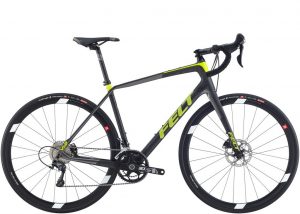 The “endurance road” category of bikes has been around in one form or another since the early 2000’s. It is the biggest category of “road bikes” in the industry.
The “endurance road” category of bikes has been around in one form or another since the early 2000’s. It is the biggest category of “road bikes” in the industry.
The Serotta Fierte, followed by the Specialized Roubaix, were some of the first endurance road bikes. Endurance road bikes are often defined by frame geometry that is more versatile and fits a wider range of riders well than most dedicated road “race” bikes. A lower center of gravity and slacker head tube angles than what is found on an ultra-focused road race geometry make for bikes that favor stability over quick (i.e. – “twitchy”) handling.
While initially developed as pavement based bikes, since the advent of disc brakes, most modern endurance road bikes can often accept 30-34mm tires. 30-34mm tires are wide enough for many riders on hardpack dirt roads. Endurance road bikes are for the rider who is looking to ride well maintained dirt roads and pavement on the same bike and be on a bike that gives up little performance or weight to a dedicated pavement race bike in the process.
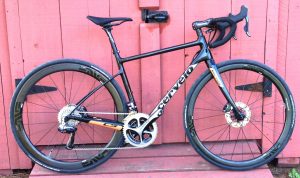 It is good to note that endurance road bikes frequently have fairly standard compact road bike gearing from the factory (50/34 in front with 11-28 or 11-32 in back). While some endurance models, like the Felt VR, use “adventure gearing” on the chainrings (48/32), these bikes will often have a tighter (higher) gearing range than an adventure capable road bike. We often work with riders to change the gearing on their new bike to suit their needs. However, factory gearing is a place where there are significant differences between (and even within) the segments of gravel road bikes.
It is good to note that endurance road bikes frequently have fairly standard compact road bike gearing from the factory (50/34 in front with 11-28 or 11-32 in back). While some endurance models, like the Felt VR, use “adventure gearing” on the chainrings (48/32), these bikes will often have a tighter (higher) gearing range than an adventure capable road bike. We often work with riders to change the gearing on their new bike to suit their needs. However, factory gearing is a place where there are significant differences between (and even within) the segments of gravel road bikes.
Bikes like the Felt VR and Cervelo C series are strong examples of the endurance road bike category. Many riders use an endurance road bike as their sole bike. These bikes can offer ample performance to keep up on the pavement while not shying away from most dirt roads.
Adventure Capable Road Bikes –
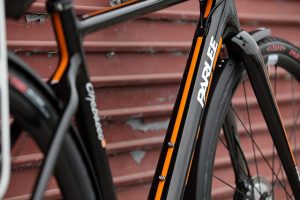 Compared to a bike in the endurance road bike segment, an adventure capable bike will be clearly defined by greater tire width capacity. Bikes in the adventure capable segment will usually be able to accept a tire of 38-40mm width compared to 30-34mm for an endurance road bike. From a fit perspective, some of these bikes (Parlee Chebacco…) will fit quite similar to bikes in the endurance road bike segment while others (Specialized Diverge, for example) will provide an even lower center of gravity and a taller stack dimension that allows for a taller relative handlebar position.
Compared to a bike in the endurance road bike segment, an adventure capable bike will be clearly defined by greater tire width capacity. Bikes in the adventure capable segment will usually be able to accept a tire of 38-40mm width compared to 30-34mm for an endurance road bike. From a fit perspective, some of these bikes (Parlee Chebacco…) will fit quite similar to bikes in the endurance road bike segment while others (Specialized Diverge, for example) will provide an even lower center of gravity and a taller stack dimension that allows for a taller relative handlebar position.
In order to allow a wider tire to fit, adventure capable bikes will usually have a longer chainstay and taller fork span than endurance road bikes. When it comes to handling and ride, this will usually mean additional compliance (comfort) and even greater stability, but at the expense of some of the snappy responsiveness and acceleration that distinguish the endurance bikes. There are many bike options in this segment and the differences are on a gradient. The higher performance bikes in this category, like the Parlee Chebacco, are even capable of being a solid cyclocross racing bike if that itch needs an occasional scratch.
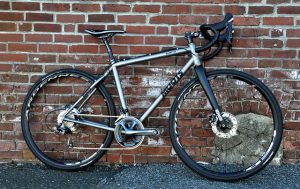 The wide tire option of the adventure capable bike makes it a good option for the rider looking to ride dirt regularly and who may be doing races like the Vermont Overland and Rasputitsa. While not as quick on pavement and hardpack dirt as an endurance road bike, the longer wheelbase and wider tire capacity of an adventure bike make it more capable when the terrain starts to get rougher, more technical and loose. The wider tire can also allow the adventure capable bike to have bags installed for bikepacking and is capable of light touring.
The wide tire option of the adventure capable bike makes it a good option for the rider looking to ride dirt regularly and who may be doing races like the Vermont Overland and Rasputitsa. While not as quick on pavement and hardpack dirt as an endurance road bike, the longer wheelbase and wider tire capacity of an adventure bike make it more capable when the terrain starts to get rougher, more technical and loose. The wider tire can also allow the adventure capable bike to have bags installed for bikepacking and is capable of light touring.
Possibly the broadest category of gravel capable bikes, 700c and 650B randoneering bikes and even cyclocross race bikes are often categorized in the “adventure bike” segment. The difference in gearing and handling between these two sub-segments is often marked. So, make sure you know what you are getting.
Touring Capable Road Bikes –
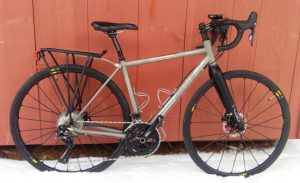 The line between touring capable bikes and adventure bikes continues to blur. Touring capable road bikes and adventure road bikes have a number of similarities.
The line between touring capable bikes and adventure bikes continues to blur. Touring capable road bikes and adventure road bikes have a number of similarities.
What truly distinguishes a dedicated touring bike is that the frame geometry is heavily biased towards stability (long wheelbase, low center of gravity, slack angles), the frame is built with tubing/materials that take into account the strength needs of carrying 40-80 pounds of additional weight on racks, and there are additional eyelets and accommodations designed specifically for loaded touring.
While there are production loaded touring bikes available, many touring bikes are custom built to serve the fit and use needs of their owners. Accommodations can include touring specific ultra-low gearing, over-sized brakes, eyelets for specific bag and rack systems, and self generating power sources that can power everything from a light to recharging a phone in the middle of nowhere.
We hope this helps you figure out what type of gravel capable bike makes the most sense for you. We’re here to answer questions and help you find the right bike fit and the right bike, so don’t hesitate to ask. We’ll outline some top gravel bike picks in an article soon.

